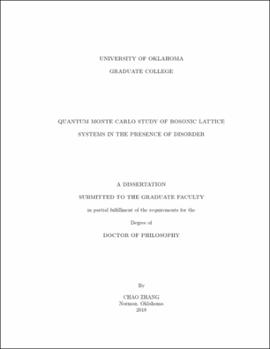| dc.description.abstract | Disorder is ubiquitous in condensed matter systems, but a thorough understanding of these systems is hindered by poor control over the nature of disorder and competing interactions. Ultracold gases trapped in optical lattices, on the other hand, offer an unprecedented level of control over interactions and disorder, and are ideal candidates to test theoretical predictions and study fascinating phenomena resulting from the interplay between disorder, interaction, and quantum degeneracy. In this dissertation, I present my research on strongly correlated many-body lattice bosons in the presence of disordered potentials. My results are based on quantum Monte Carlo simulations by the Worm algorithm. Experimentally, lattice bosons can be realized by ultracold gases in optical lattices. I studied the ground state phase diagram of the above systems in the presence of diagonal (quasi-periodic disordered potential or random disordered potential) and off-diagonal disorder (in the form of site dilution). First, I will discuss the ground state phase diagram of two-dimensional bosons in quasi-periodic lattices. Then, I will discuss the phase diagram as well as finite temperature thermodynamic properties of two-dimensional dipolar lattice bosons in the presence of random diagonal disordered potentials. Finally, I will discuss the phase diagram of two-dimensional hard-core lattice bosons system in the presence of long-range hopping and long-range two-body interactions both in the absence of disorder and in the presence of site dilution (equivalent to off-diagonal disorder). This system is equivalent to the long-range XXZ model as realized by polar molecules trapped in a deep optical lattice. These results provide theoretical guidance for experimentalists to find quantum phase transitions as well as exotic quantum phases in strongly correlated bosonic lattice systems. | en_US |
